By Ana Rosa Ibañez | Translation: Ana Rosa Ibañez
It’s been a while since I last wrote, I was somewhere between busy and uninspired. Luckily, something happened in this show that awoke a kind of innocent curiosity that was half hibernating, half consumed and honestly half tired of the conventional formats in which we write and critic. It was in the house-studio of an artist (Thank you, Adam Nankervis!), set as a run down version of a gallery, that I encountered the last Works of Nina De Felice, an emerging artist.
The paintings were hanging all over the walls of this classic Berlin flat, worn out by the time and use of his owner, which opposed to the flat, was far for classic. With his permission, I would like to call him eccentric (that being the best compliment that I can give). Scattered in Adam’s room, in the kitchen, against a block of cardboard boxes, hanging from the chairs; you could find paintings in any corner of the house. Balloons from a past birthday and a tower of biscuit boxes were keeping them company. Everything related harmoniously, as if the paintings had been done right there and were old friends with the rest of the stuff, of the paintings and the food. They were having their own little party. Behind a wall of tobacco smoke, while the deem light allowed for the red wine to confabulate together with the books, the sculptures, plants and pretzels; the paintings looked friendly and accessible. There were no glass or frames separating us from Nina’s brush strokes. Just paper nailed to the wall, with no narcissistic pretensions.
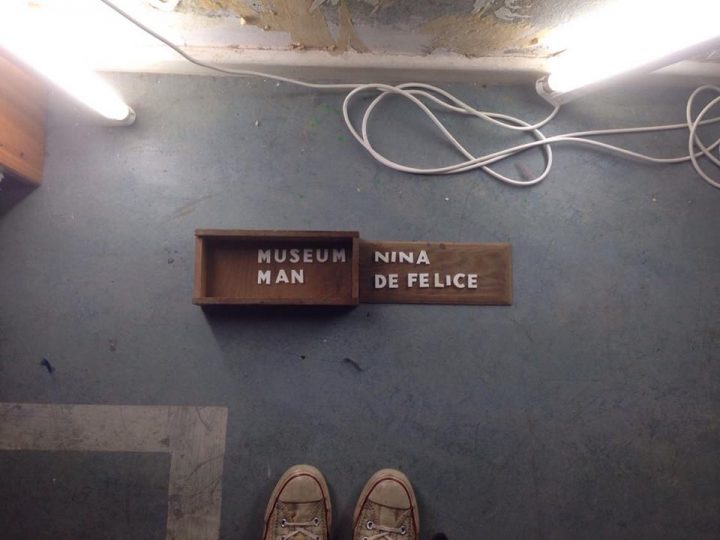
I was lying on Adam’s bed, already a bit drunk and emotional while everyone took turns to sing some tune from the various countries that we came from, an existentialist feeling took over me and before I could stop it I was already analysing what was taking part in the situation to provide this amount of delight, so much that my head was boiling hot. How come that this show was so simple, so direct and the paintings came out so easily; and in which moment did we pass from this to white cube, high heels and shiny coloured-pants. What was it about this paintings that was making me feel so close to them and so pleasant? I didn’t feel like analysing them from the markets point of view, or historical context, or nothing that I’ve learned in books lately. One or two references came to my head but mainly I was enjoying not thinking. Not bothering these day-to-day, decadent characters, respecting their enigmas before trying to trap their spirits in a box and dissect them into text.
I realized also that there was something about honest and simple work, something about disinterested collaboration, something about the uncommitted audience; the ones that come because they really want to be there, not because their spectators or consumers, even though there were just a few of us and there were no photographers; and all of that made me feel comfortable.
Of course it wasn’t the first time that I encountered a project like this one, we were not inventing the wheel, but having been very irresponsible regarding my exhibitions visiting, I realized that I missed this, and I could suddenly appreciate it from a fresh perspective. I felt inspired.
Due to us living in different countries, Nina and I started a dialogue via email, and without planning it, we ended up discussing our perspectives on the contemporary art world: the gallerist (truths and prejudices), the artist and the works themselves.
Introducing Nina
So, you are originally from New Jersey, how similar or how different do you find the art scene in Berlin? Do you enjoy being an artist in this city?
I grew up in New Jersey but moved to Washington DC when I was 17 to start university. I can’t say much for the art scene in New Jersey, but as far as the art scene in DC I’d say Berlin offers a more experimental environment. While there are a ton of interesting places exhibiting a large variety of art, I still find it doesn’t compare to Berlin. I attribute that to the low cost of spaces in Berlin and the free lifestyle the city offers. Both have their pros and cons, I find it at times overwhelming to be an artist in Berlin. It’s a challenge to not drown in all of the art as an artist but that also keeps me working harder and inspired.
You’re exhibition at Museum MAN in Berlin has just ended; the space and also the hanging (or not hanging) of the paintings was very interesting, quite far from the conventional “white cube” type of gallery. Are you satisfied with how your work related to the environment?
I love seeing my work in that context. First of all I love the environment there and the walls! The walls make everything look good. I took part in a group exhibition in a warehouse turned gallery in Baltimore, which has a similar feel to it. Bare concrete walls and a ton of character. I paint on paper because I like the rough edges of the paper and the shadow they cast on a plain white gallery wall so the imperfections of the rough concrete walls are relate very much so to how I create my paintings.
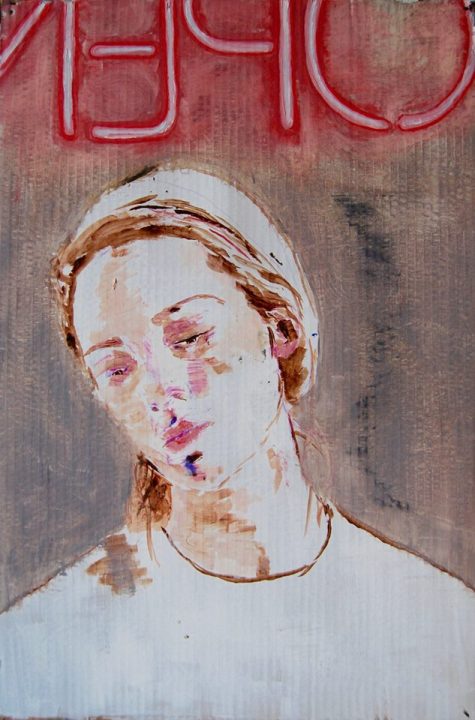
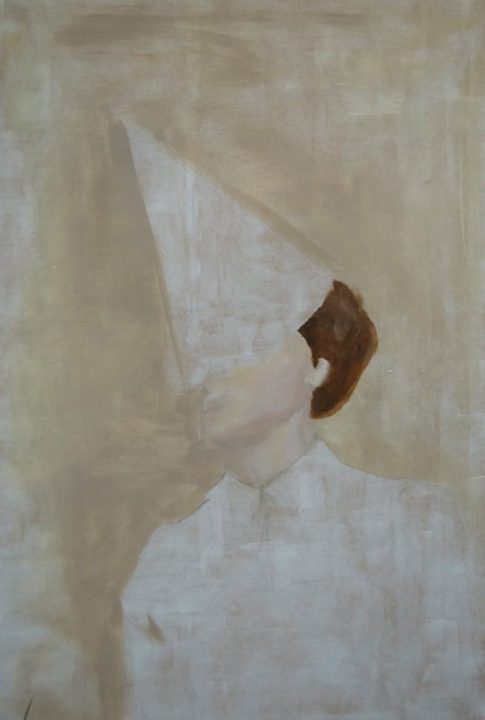
It’s amazing that you felt comfortable enough to experiment with your work, receiving support of Adam like that. Have you worked with a gallerist before? How would you compare the experience?
I guess you could say I’ve worked with gallerists before, but never to the extent that I’ve worked with Adam. I studied at a museum art school so we were constantly hanging shows and working with the curators at the museum, but they also encouraged us to try our own thing and take charge. Adam is like a treasure trove of information and stories; he almost puts my art history courses to shame! He has this persona that everything he does is creating, but he is also very professionally savvy. I’ve learned a lot from working with him and from spending time at AVS. I think I became more comfortable with experimenting with ideas and not worrying that every painting had to be a masterpiece. That’s a huge help. I think I’ve maybe been fortunate as far as the galleries that I’ve worked with so far goes. With almost all I’ve been able to relate to the gallerists on a personal level, some more than others but I’ve had no bad experiences so far.
I’m glad you’ve had good experiences, I don’t know why I have my reserves when it comes to the art market; I’m usually expecting the artist to be on the lose side of the exchange. This probably comes from my personal experience… I come from a place where the market can be quite narrow and for the same reason, somewhat brutal, specially between galleries… So, you feel encouraged by the art system today to pursue your career as an artist? Would you consider that we are in a time where artists have options and opportunities? (I’m hoping for you to smash my prejudices again…)
I have heard a fair share of horror stories, for that reason I go into most situations pretty skeptical. I’ve had small situations where I’ve lost painting sales from gallerists bumping up the prices to make a bigger profit for themselves, but I think that’s a pretty common thing. Working with Adam is really a fortunate case though because he works his gallery as a project space so he doesn’t take any profit. He’s just totally in it for the artists. I also super often get invited to take part in shows then find out there is a huge participation fee, that’s something that really gets on my nerves and I would never agree to. A gallery taking a small percentage of the sales I can understand. They need to keep the gallery open somehow, but to pay just to show is crazy!
I think in many ways the art market totally goes through phases and it’s hard to not try to follow the trends to be more relevant or successful, but there are ways around it and there’s only so long a certain style or medium can be “in”. I wouldn’t say I’m totally encouraged by the art system, the chances that sooner or later I’ll come across a bad gallery situation are probably pretty high, but I love painting too much to give it up! Of course this may change if I do get screwed, in which case I’ll keep you posted!
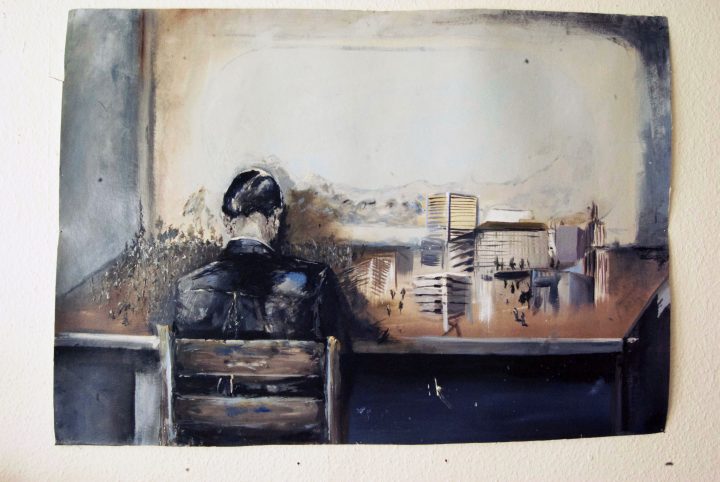
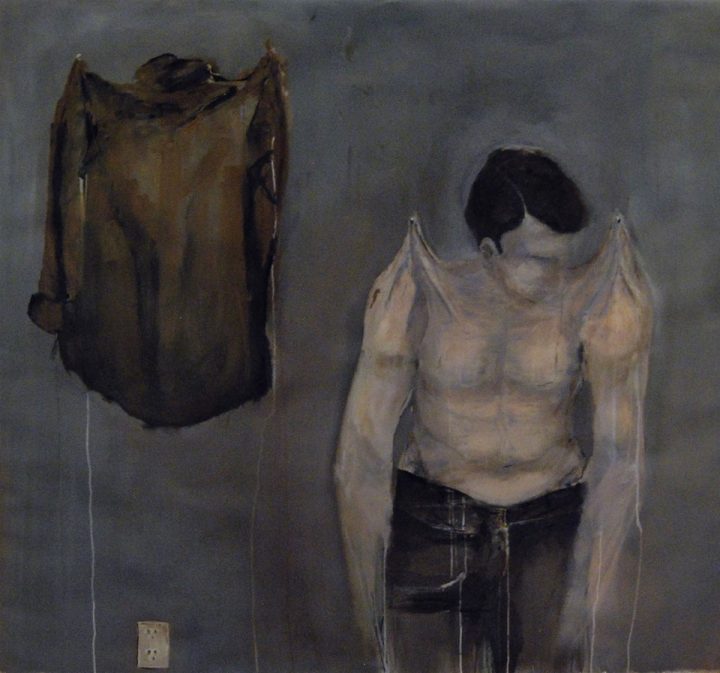
Let’s talk about your paintings. The rough edges of the paper seems to be a very important element, they look almost ripped. They are not framed, they are nailed to the wall as if they were unfinished, or in process. Was that a previous decision? It relates so well to the people in the paintings; also a bit blurry, a bit rough around the edges… can you tell me a bit of the people you paint?
Yes, the rough edges are very important. The way I paint is so haphazard, I love to make messes when I’m painting so I feel like making the edges clean and mounted seems dishonest of my process and my energy when I’m working on a painting. I also like the juxtaposition of the “cookie cutter” figures I paint, in particular in my earlier work, with those messy edges. The people I paint are meant to portray the mundanity of life and the touch on subjects like western values, gender studies and societal pressures which all sort of categorize people into neat boxes but in reality people are so much more complex than society allows. I think that subject matter on a messy surface is an interesting mix. I also aesthetically love the look of things nailed to the walls.
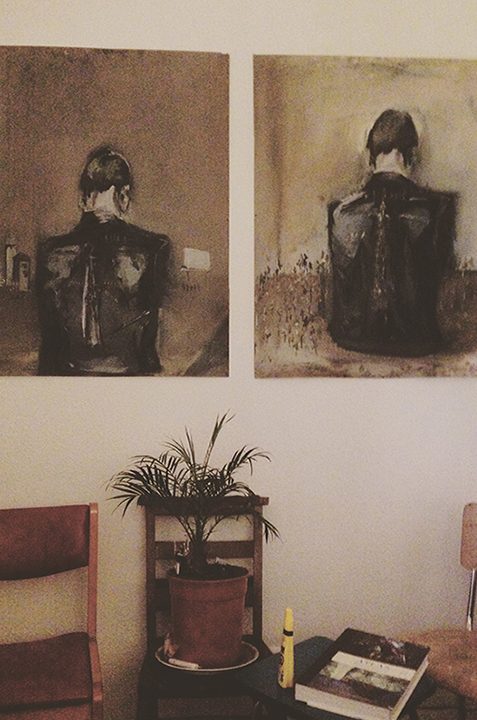
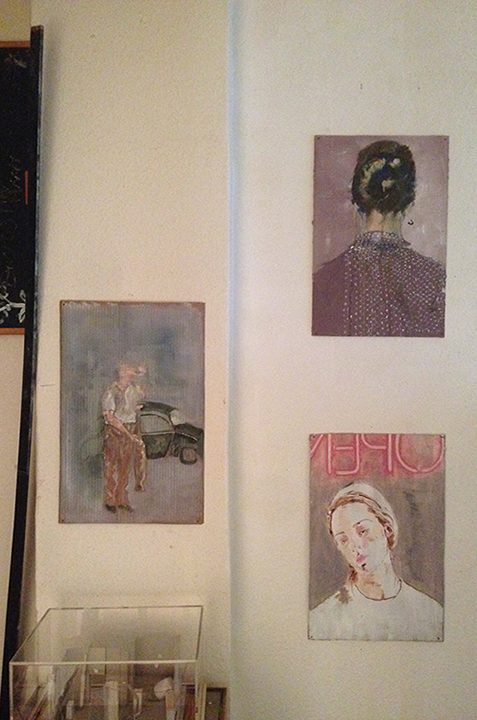
You mentioned in the exhibition that sometimes the nails damaged the paintings, and you had to repair them. Aren’t you concerned with the deterioration of the paintings? Not framing can also endanger the preservation of the pigment… do you think the artwork should have an “eternal life”?
Yes, I am constantly repairing them! That’s a pain. For some bigger shows I’ve built platforms to mount the paintings, so that helps a little bit but they’re still exposed to everything. I’m really into textures and I feel like framing a painting behind glass hides the texture. At the same time I don’t want all of my paintings completely deteriorated in twenty years. It’s something I’m still working on figuring out. I use many layers of primer and coating to keep them in better shape but that’s not a forever fix.
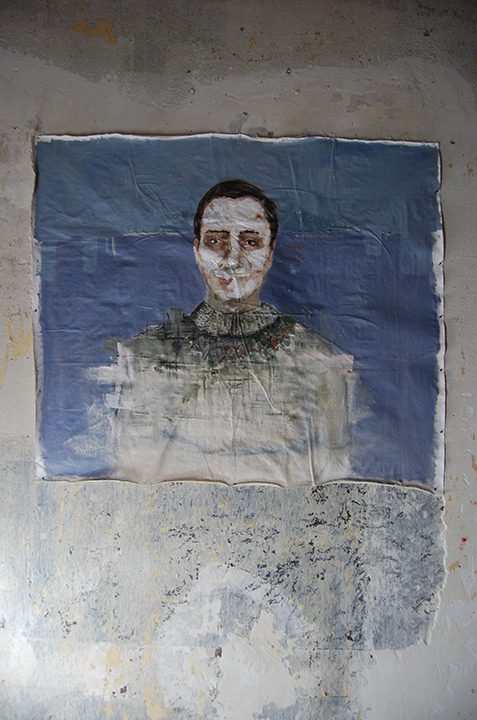
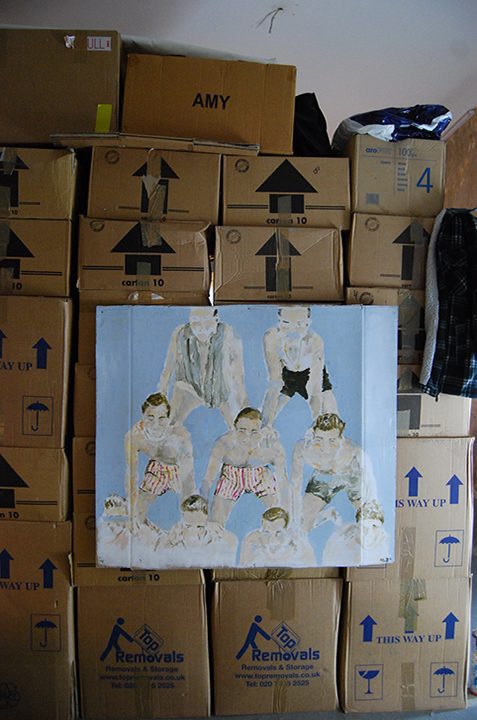
Paintings of a society constantly deteriorating maybe? I think it holds a beautiful consistency. The images itself are not sad but leave you with a taste of nostalgia. I think it has something to do with the color palette and the brush stroke also… besides the texture that you mention of course. Very wholesome! It also reminds me a bit of Lucien Freud… Who would you say inspired you the most to follow this style?
Ooh, “paintings of a society constantly deteriorating”- I love that! Totally! Definite nostalgia, it’s not a feeling that I go into the paintings concentrating on but it seems evident once I’m finished with one. Lucien Freud is one of my favorite artists, the textures in his paintings are incredible! (I once set off an alarm at a museum for getting too close to one of his paintings because I had to get a better look at those textures!) I also really love the work of Francis Bacon and Luc Tuymans! I also get a lot of inspiration from books and films. Reading “1984” and “Death of a Salesman” really put me in inspiration overdrive.
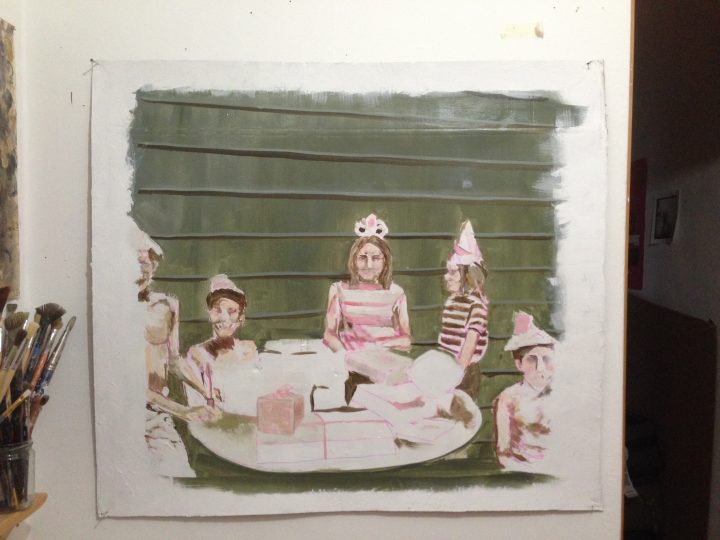

 Español
Español